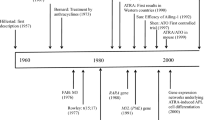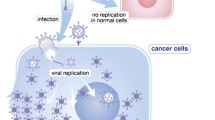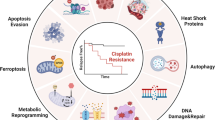Abstract
PDCD5 (programmed cell death 5) accelerates apoptosis of certain tumor cells and the replication-defective Ad-PDCD5 may be a promising agent for enhancing chemosensitivity. In this study, a triple-regulated conditionally replicating adenoviruses (CRAd) carrying PDCD5 gene expression cassette, SG611-PDCD5, was engineered. In SG611-PDCD5, the E1a gene with a deletion of 24 nucleotides within CR2 region is controlled under the human telomerase reverse transcriptase (hTERT) promoter, the E1b gene expression is directed by the hypoxia response element (HRE), whereas the PDCD5 gene is controlled by the cytomegalovirus promoter. The tumor-selective replication of this virus and its antitumor efficacy were characterized in several leukemic cell lines in vitro and in xenograft models of human leukemic cell line in nude mice. It was found by RQ-RT-PCR assay that SG611-PDCD5 expressed PDCD5 efficiently in leukemic cells. In K562 tumor xenograft models, SG611-PDCD5 displayed a tumor killing capacity. At a dose of 1 × 109 plaque-forming units, SG611-PDCD5 alone could completely inhibit the tumor growth and more effective than replication-defective Ad-PDCD5. Histopathologic examination revealed that SG611-PDCD5 administration resulted in leukemic cell apoptosis. We concluded that the triple-regulated SG611-PDCD5, as a more potent and safer antitumor therapeutic, could provide a new strategy for leukemia biotherapy.





Similar content being viewed by others
References
Miyake H, Hara I, Hara S, Arakawa S, Kamidono S (2000) Synergistic chemosensitization and inhibition of tumor growth and metastasis by adenovirus-mediated P53 gene transfer in human bladder cancer model. Urology 56:332–336
Tuve S, Racek T, Niemetz A, Schultz J, Soengas MS, Putzer BM (2006) Adenovirus-mediated TA-p73beta gene transfer increases chemosensitivity of human malignant melanomas. Apoptosis 11:235–243
Okumura K, Nakase M, Nakamura S, Kamei T, Inui M, Tagawa T (2007) Bax gene therapy for human osteosarcoma using cationic liposomes in vivo. Oncol Rep 17:769–773
Ruan GR, Zhao HS, Chang Y et al (2008) Adenovirus-mediated PDCD5 gene transfer sensitizes K562 cells to apoptosis induced by idarubicin in vitro and in vivo. Apoptosis 13:641–648
Su C, Peng L, Sham J et al (2006) Immune gene-viral therapy with triplex efficacy mediated by oncolytic adenovirus carrying an interferon-gamma gene yields efficient antitumor activity in immunodeficient and immunocompetent mice. Mol Ther 13:918–927
Jounaidi Y, Doloff JC, Waxman DJ (2007) Conditionally replicating adenoviruses for cancer treatment. Curr Cancer Drug Targets 7:285–301
Su CQ, Sham J, Xue HB et al (2004) Potent antitumoral efficacy of a novel replicative adenovirus CNHK300 targeting telomerase-positive cancer cells. J Cancer Res Clin Oncol 130:591–603
Zhang Q, Nie M, Sham J et al (2004) Effective gene-viral therapy for telomerase-positive cancers by selective replicative-competent adenovirus combining with endostatin gene. Cancer Res 64:5390–5397
Zhang Q, Chen G, Peng L et al (2006) Increased safety with preserved antitumoral efficacy on hepatocellular carcinoma with dual-regulated oncolytic adenovirus. Clin Cancer Res 12:6523–6531
Wang X, Su C, Cao H et al (2008) A novel triple-regulated oncolytic adenovirus carrying p53 gene exerts potent antitumor efficacy on common human solid cancers. Mol Cancer Ther 7:1598–1603
Liu H, Wang Y, Zhang Y et al (1999) TFAR19, a novel apoptosis-related gene cloned from human leukemia cell line TF-1, could enhance apoptosis of some tumor cells induced by growth factor withdrawal. Biochem Biophys Res Commun 254:203–210
Wang Y, Li X, Wang L et al (2004) An alternative form of paraptosis-like cell death, triggered by TAJ/TROY and enhanced by PDCD5 overexpression. J Cell Sci 117:1525–1532
Chen Y, Douglass T, Jeffes EW et al (2002) Living T9 glioma cells expressing membrane macrophage colony-stimulating factor produce immediate tumor destruction by polymorphonuclear leukocytes and macrophages via a “paraptosis”-induced pathway that promotes systemic immunity against intracranial T9 gliomas. Blood 100:1373–1380
Dal Canto MC, Gurney ME (1994) Development of central nervous system pathology in a murine transgenic model of human amyotrophic lateral sclerosis. Am J Pathol 145:1271–1279
Xu XR, Huang J, Xu ZG et al (2001) Insight into hepatocellular carcinogenesis at transcriptome level by comparing gene expression profiles of hepatocellular carcinoma with those of corresponding noncancerous liver. Proc Natl Acad Sci USA 98:15089–15094
Hedenfalk I, Duggan D, Chen Y et al (2001) Gene-expression profiles in hereditary breast cancer. N Engl J Med 344:539–548
Zucchi I, Mento E, Kuznetsov VA et al (2004) Gene expression profiles of epithelial cells microscopically isolated from a breast-invasive ductal carcinoma and a nodal metastasis. Proc Natl Acad Sci USA 101:18147–18152
Yang YH, Zhao M, Li WM et al (2006) Expression of programmed cell death 5 gene involves in regulation of apoptosis in gastric tumor cells. Apoptosis 11:993–1001
Li H, Wang Q, Gao F et al (2008) Reduced expression of PDCD5 is associated with high-grade astrocytic gliomas. Oncol Rep 20:573–579
Ruan GR, Qin YZ, Chen SS et al (2006) Abnormal expression of the programmed cell death 5 gene in acute and chronic myeloid leukemia. Leuk Res 30:1159–1165
Ma X, Ruan G, Wang Y et al (2005) Two single-nucleotide polymorphisms with linkage disequilibrium in the human programmed cell death 5 gene 5’ regulatory region affect promoter activity and the susceptibility of chronic myelogenous leukemia in Chinese population. Clin Cancer Res 11:8592–8599
LaBarre DD, Lowy RJ (2001) Improvements in methods for calculating virus titer estimates from TCID50 and plaque assays. J Virol Methods 96:107–126
Yu W, Fang H (2007) Clinical trials with oncolytic adenovirus in China. Curr Cancer Drug Targets 7:141–148
Garber K (2006) China approves world’s first oncolytic virus therapy for cancer treatment. J Natl Cancer Inst 98:298–300
Wirth T, Kuhnel F, Kubicka S (2005) Telomerase-dependent gene therapy. Curr Mol Med 5:243–251
Post DE, Devi NS, Li Z et al (2004) Cancer therapy with a replicating oncolytic adenovirus targeting the hypoxic microenvironment of tumors. Clin Cancer Res 10:8603–8612
Cho WK, Seong YR, Lee YH et al (2004) Oncolytic effects of adenovirus mutant capable of replicating in hypoxic and normoxic regions of solid tumor. Mol Ther 10:938–949
Cogulu O, Kosova B, Karaca E et al (2004) Evaluation of telomerase mRNA (hTERT) in childhood acute leukemia. Leuk Lymphoma 45:2477–2480
Huh HJ, Huh JW, Yoo ES et al (2005) hTERT mRNA levels by real-time RT-PCR in acute myelogenous leukemia. Am J Hematol 79:267–273
Tchirkov A, Chaleteix C, Magnac C et al (2004) hTERT expression and prognosis in B-chronic lymphocytic leukemia. Ann Oncol 15:1476–1480
Bock O, Serinsoz E, Schlue J, Kreipe H (2004) Different expression levels of the telomerase catalytic subunit hTERT in myeloproliferative and myelodysplastic diseases. Leuk Res 28:457–460
Su C, Cao H, Tan S et al (2008) Toxicology profiles of a novel p53-armed replication-competent oncolytic adenovirus in rodents, felids, and nonhuman primates. Toxicol Sci 106:242–250
Acknowledgments
This study was supported by the grant from National Natural Science Foundation of China (No.: 30670894) and supported in part by the grant from the National High Technology Research and Development Program of China (863 Program) (No.: 2006AA02A405).
Author information
Authors and Affiliations
Corresponding author
Rights and permissions
About this article
Cite this article
Xie, M., Niu, JH., Chang, Y. et al. A novel triple-regulated oncolytic adenovirus carrying PDCD5 gene exerts potent antitumor efficacy on common human leukemic cell lines. Apoptosis 14, 1086–1094 (2009). https://doi.org/10.1007/s10495-009-0373-3
Published:
Issue Date:
DOI: https://doi.org/10.1007/s10495-009-0373-3




